2007
Gooding Trice House 2377
Gooding House
Gooding Trice Villa 2378
Gooding House
Villa Skeleton
Working Title Museum 005 2379
Le Composites 2380
Capital Complex at Chandigarh
Governor's Palace
St. Pierre Firminy-Vert
Palais des Congrès
Hotels at the Palais des Congrès
House of Shadows Bye
Domestic Museum 2381
Villa Rotunda
Ury House and Farm
Whitemarsh Hall
Villa Stein de Monzie
Villa Savoye
House Under a Common Roof
Goldenberg House
Maison l'Homme
House 10: Museum
Motherhouse of the Dominican Sisters
Housing for La Villette
Retreat House
Wagner House
House for Karl Friedrich Schinkel
Cooper & Pratt House
Ur-Ottopia House
House of Shadows Bye
Gooding Trice House
Jung Zaha House 2382
Villa Stein de Monzie
Villa Stein de Monzie in Terrain 2383
Bye House in Terrain 2384
Trivilla Savoye 2385
Villa Savoye
Old School of New Thinking 2007
National Library of the Czech Republic
Cut & Paste Museum 2386
Altes Museum
Philadelphia Museum of Art
House 10: Museum
Museum for Nordrhine-Westfalen
Duchamp Inn 2387
The Large Glass
Calder Museum
2007.01.01 21:40
philip johnson was a whore. rem koolhaas is a porn star.
philip johnson was a bore.
rem koolhaas is a car horn.
steven holl has a fetish...

2007.01.05
ideas
6. There is the idea of going very easy recombinant with the Quondam cad collection, and in the process generating a new narrative for Quondam. Ottopia is more or less the context, but so is Quondam itself, and so is reality (filtered through the virtual).
2007.01.09
some progress
[recording] The cad databases are taking time, and it is kind of tedious work. There are some inspirations that occur during the process while seeing the databases, but who knows if I'll ever do anything except just forget that I was ever inspired.
I do like the notion of continuing to use the databases as part of an ongoing architectural narrative at Quondam. Right now I'm not sure what that narrative will be, but I'll probably keep it in the context of Ottopia/Romaphilia. The narrative might also be about Quondam itself.
2007.01.12 14:41
any suggestion about Manual DeLanda courses in Upenn
Don't tell me it boils down to mind candy!
2007.01.15 22:22
Minimalism in Architecture
"less walls is more windows"
or
"less windows is more walls"
2007.01.16 15:14
Minimalism in Architecture
"In the future, everything will be an advertisement." Even minimalism.
2007.01.24 12:19
for marcel breuer's admirers
... and get that great new book on the workings of inspiration. I'm pretty sure it's called Even You Can Be A Copy Cat.
2007.01.24 12:08
The age of technological revolution is 100 years dead
"In the future, your whole life will be a phone call."
2007.02.07
meaning of labyrinth, etc.
I remembered last night that I recently read a good explanation of labyrinth (vis-à-vis architecture) and then thought how it relates to Piranesi's Campo Marzio plan, or at least how the labyrinth relates to some of the interpretations of the Ichnographia. I now think the passages read was within L.B. Alberti's Hypnerotomachia Poliphili.
"Along with incomprehensible epigrams and inscriptions, unknowable animals and humans, the Hypnerotomachia is full of obscure, dark, intractable places: forests, veiled entrances, labyrints. Indeed, the labyrinth--a kind of emblem of hermetic difficulty, the symbol par excellence of search and the abstract model for most kinds of problem-solving activities--marks almost every step of the hero's wanderings as he makes his way through the story. As early as the first chapter, the reader follows the hero through a forest as he exclaims, "I had as my only recourse to implore the pity of the Cretan Ariadne, who gave the thread to Theseus to get out of the difficult labyrinth." Readers are constantly finding themselves within labyrinths: one inside the viscera of the temple at the base of the pyramid; an aquatic one in the form of a circular, maze-like pool; the concentric-patterned garden on the island of Cythera; and the subterranean spaces under a landscape of ruins."
"The book itself is a labyrinth, a series of veils, a cryptic epigram."
Liane Lefaivre, Leon Battista Alberti's
Hypnerotomachia Poliphili, pp. 90, 91.
07021501 Acropolis Q model Haus der Kunst plan
3392mi01
2266i11
07030802 Acropolis Q plans model IQ plans
2266i12
b
2007.03.10 20:42
...and speaking of random tangents
"In the summer of 1800, when the architect was away on his wedding trip, [John] Barber absconded, taking with him a considerable sum of money and all the most valuable office and personal papers."
--Hamlin
And the John Barber Award for Architectural Deviance goes too...
2007.03.12 17:05
...and speaking of random tangents
"In a sense Asimov, Heinlein, and the masters of American Science Fiction are not really writing of science at all . . . They're writing a kind of fantasy fiction about the future, closer to the Western and the Thriller, but it has nothing really to do with science . . . Freud pointed out that you have to distinguish between analytic activity. which by and large is what the sciences are, and synthetic activities which are what the arts are. The trouble with the Heinlein-Asimov type of Science Fiction is that it's completely synthetic. Freud also said that synthetic activities are a sign of immaturity, and I think that's where classical Science Fiction falls down."
--Ballard, Speculation, 1969.
Upon first reading this passage, thoughts of how Piranesi's Il Campo Marzio dell'Antica Roma and particularly the Ichnographia Campi Martii have been largely misinterpreted by 20th century architectural 'scholarship' came to mind. The synthetic quality of Piranesi's archaeology (before archaeology was formalized into a science) is all the critics/theoreticians saw, and they completely discounted the analytical aspect of Piranesi's archaeology. Basically, a non-analytical analysis resulted in a synthetic interpretation.
The wonderful thing about Il Campo Marzio dell'Antica Roma (including the Ichnographia Campus Martius) is that the distinction between the analytical and the synthetic is never manifest--the work seamlessly embodies both natures.
[note to self: think about an updated republication of "Theatrics Times Two" and "Theatrics Times Two, too".]
"Science now, in fact, is the largest producer of fiction. A hundred years ago, or even fifty years ago even, science took its raw material from nature. A scientist worked out the boiling point of a gas or the distance a star is away from the Earth, whereas nowadays, particularly in the social, psychological sciences, the raw material of science is a fiction invented by the scientists. You know, they work out why people chew gum or something of this kind . . . so the psychological and social sciences are spewing out an enormous amount of fiction. They're the major producers of fiction. It's not the writers anymore."
--Ballard, Speculation, 1969.
2007.03.12 21:46
...and speaking of random tangents
As to "It raced so fast the pulse exited a specially prepared chamber before it even finished entering it," that book may already be written---perhaps either Einstein's General Relativity or Special Relativity. (But don't quote me on that.)
As it stands, to me, the sentence relates the pulse being quickly stretched between the entry and exit points of the chamber.
But the sentence may not even be correctly describing what really happened:
Perhaps it meant to say the pulse completely exited the chamber at a time in the past relative to its entry time.
or
Perhaps it meant to say the pulse bilocated, being at two locations but not at the same time; again, the second space/time occurred before the first space/time.
This is what the whole time warp theory is about. Or at least it's what it used to be all about. Or maybe theories quickly exit before they finish entering.
07040502 PMA model 5233
2142i16
2166i21
2007.04.09 23:29
3DH Gallery
The idea of this system was developed in 1637 in two writings by Descartes. In part two of his Discourse on Method Descartes introduces the new idea of specifying the position of a point or object on a surface, using two intersecting axes as measuring guides. In La Géométrie, he further explores the above-mentioned concepts.
--wikipedia
So let me rephrase...
The xyz coordinate system is not necessarily the same thing as Cartesian rationalism.
Interestingly...
The work, La Géométrie, was responsible for introducing the Cartesian coordinate system, which is a mathematical graph in which x is the horizontal line and y is the vertical line, and in which the positive numbers on the x line are on the right and the negative numbers on the left, and the positive numbers on the y line are on the top and the negative numbers are on the bottom, and specifically discussed the representation of points of a plane, via real numbers; and the representation of curves, via equations.
--wikipedia
So the system was not so much a rational cage, rather a method to represent curves?!
2007.04.09 18:54
evolutionary architecture?
No, extinction means extinction, as in evenually not there anymore.
And, one could well say that Stirling practiced architectural design as an ongoing development of architecture's very historical DNA code.
Perhaps the environment and users now-a-days evolve a lot quicker than building ever could.
It seems to me that the more specifically designed a building is (and even buildings specifically designed to change over time), the quicker those building become obsolete.
2007.04.09 20:29
evolutionary architecture?
The interior of the simple loft building can be just as easily changed.
I forget where, but I read how the Theater of Marcellus has been renovated into multi-story apartments like over a thousand years ago.
Obsolete-ness is gauged by time endurance. I'd say any building that lasts over several centuries has a low obsolete factor. And buildings that last less than a half century have a high obsolete factor. (Planned obsolescence is a whole other (artificial) story.)
Also, the obsolescence of a building's function does not necessarily make the building itself also obsolete (as a sheltering structure). That is, of course, unless the building is designed only for a highly specific function. Moreover, buildings with great space(s) and structure(s) to begin with usually last longer too.
I think Vanbrugh is my first favorite English architect (although I'm just now learning of Latrobe's English work).
2007.04.20 18:27
Featured Discussion: Volume
Because education is today an expensive commodity, and because magazines are at best advertising mediums and because architects are now seeking to commodify their research (abilities), I thought of Leon Krier's "The Consumption of Culture" in Oppositions /14 (1979).
first sentence:
"When the French Revolution ended with the political victory of the bourgeoisie, education, which had been the priviledge of a small class, became compulsory for every member of the new social order.
somewhere in the middle sentence:
"Kitsch must then be identified as the most important cultural phenomenon of the industrial age, as the real Zeitgeist of the machine age.
last sentence:
"In that perspective, the self-destruction of humanity becomes obviously a moment of relief, relief from the urgency, ugliness , and futile agony.
Putting the content of all those old magazines online, now that would be a more worthwhile exhibit.
2007.04.21 13:22
Featured Discussion: Volume
Look up magazine in a good dictionary.
1 a : a place where goods or supplies are stored
2 a : a place to store ammunition
Bouman states Volume's position well. But the whole "kind of de-territorialized" stance is weak, tepid at best.
As an architect, with no practice, a dormant license, no ties to any institution, no real contact with other architects and very little real contact with other people, yet, via the internet, still operating within the architectural realm and even having some effect (big effect even if the full range from negative to positive is considered), I know all about de-territorialization because, as an architect, de-territory is the only place I am. [An interesting twist in this particular discussion (place) is that Mark Wigley is the only person here that has actually met me, and thus he knows just how de-territorialized I actually am.]
Oddly, de-territorialization is what provided me with an architectural comfort zone.
[note to self: how does bilocation relate to de-territorialization? Is bilocation like a hyper inverted de-territorialization??]
2007.04.22 19:59
Featured Discussion: Volume
I referred to my stance as an architect as de-territorialized, but not to Quondam.
My de-territorialized stance may be reflected within the content published at Quondam, but Quondam itself doesn't attempt de-territorialization any more than any other virtual place attempts de-territorialization.
If there is anything I learned via de-territorialization and Quondam it's that limits are not worth reaching for.
2007.04.23 15:41
Featured Discussion: Volume
It seems to make sense that de-territiorialization ultimately registers a re-territorialization, but it is the effect of de-territorialization (on one's thinking) that is the most important aspect here. And I guess you could say that new mode of thinking is what then shapes the new "territory".
I have no idea if this is so, but I wonder if this composition might be an example of de-territorialized architecture.
| |
2007.04.23 17:08
Featured Discussion: Volume
Firminy church by Le Corbusier
Hurva synagogue by Kahn
composition 1a : the act or action of composing : the formation of a whole especially by different things being put together
To confuse or not to confuse, that is de-territorialization?
The church/synagogue composition came as a result of seeing how the plan of the church fit almost perfectly within the sanctuary(?) of the synagogue. And, since I had a model of both buildings, I just wanted to see the superimposition in 3D. And upon seeing that I thought, "Gosh, that kinda looks like a mosque." Trust me, de-territorialized thinking isn't necessarily brilliant, although for the most part uninhibited.
Anyway, back to Volume....The reporter on the radio just said, "Heavy volume on Passyunk Aveune..." Hey, traffic would make a great theme for a heavy issue. Trafficking in Architecture--I wanna write about stolen goods.
I think Passyunk is an old 'Indian trail'. Wow, Philadelphia's Indian trails, talk about de-territorialization.
2007.04.23 20:46
Featured Discussion: Volume
"It turns out that humpback whales riff off each other, remixing one another's songs, and developing trends and fashions in their singing over time." Who told them about composition?!?
2007.04.25 10:24
Featured Discussion: Volume
"...a 'hard copy' tool that brings in more architectural clients..." -- Was Le Corbusier subliminally advertising? Did the publication of SMLXL coinciding with an exhibit at MoMA bring Koolhaas/OMA more clients? I'll say probably and probably.
(I assume) clients look for someone they can trust, and they probably do that by seeing what architects are already trusted.
But your answer is viable, nonetheless. Just also be aware that the architectural field is repleat with (subliminal) copy-cats.
The client asks:
Are you an architectural brand or are you an architectural knockoff?
The architect responds:
That depends, are you a brand client or are you a knockoff client?
How many clients do you think I'd attract with "hardcopy" entitled Volume and Congestion?
07050301 Hurva Dormitories plan
2375i01
07050302 Hurva Dormitories plan model
2375i02
07050601 Hurva Dormitories elevation axonometrics perspectives
2375i03
2007.05.10 11:39
your favorite quote
"History has a way of interpolating itself."
-Stephen Lauf 2007.05.10
2007.05.18 11:53
lost endings
Judith stops Quentin from harassing Edith. Edward Collins returns to Collinsport with a new governess, Rachel Drummond, for the children. Barnabas meets with Edith Collins; she is shocked and declares that he is the secret. Edward tries to get Edith to tell him the secret.
Joshua and Nathan investigate Suki's murder, they find Josette at the Old House. Millicent finds out that Suki was Nathan's wife. Bite marks are found on Josette's neck, and it is feared that Josette will die as written in the family history book.
Roger picks Victoria up to drive her home. She tells him about finding out that Burke's pen was missing and that it was the same pen that she found on the beach where Bill Malloy died. Roger doesn't want her to mention the pen again even though this could be used against Burke, Victoria is puzzled. Roger finds the road cut off by water from the storm, he is unable to start the car back up. Victoria and Roger find a small shack to get out of the storm. They then talk about the pen again, Victoria wants to go to the police, Roger gets very angry with her. Victoria is now really confused. The sheriff finds Roger and Victoria and helps them get home.
Barnabas plans the costume party. Victoria is very excited about the party, but Elizabeth still has some reservations. Victoria helps Barnabas pick the clothing that everyone will wear. One of the pieces of clothing is a little girl's dress which belonged to Sarah Collins. Later Sarah appears and finds her dress.
Ben figures out they're waiting for a helicopter, so he asks the island for a helicopter. Ben's helicopter comes to the rescue, and "our group" happily get on board. Surprise! Surprise!
2007.05.18 14:57
lost endings
I do remember the Dark Shadows remake. It followed the same exact storyline as the original. What was good about the original, however, was how convoluted the storyline got over time; ultimately an occult encyclopedia of sorts. The low production value of the original show also had its charm.
What I see in LOST is the same type of convoluted (complicated; intricately involved) storyline filled with clandestine, sort of encyclopedic clues. What seems somewhat unique to LOST though is its way of character development via real time portrayal and flashback. This operation manifests (at least) a double theater, which is a very fecund, indeed baroque, story-telling vehicle that is not often used.
07052801 Gooding Trice House plans
2377i01
07052802 plan model axonometrics
2377i02
b
07052803 perspectives axonometrics
2377i03
2007.06.03 23:54
Archinect @ Postopolis!
I'd say a de-territorialized critic is even more dangerous.
2007.06.04 00:08
Archinect @ Postopolis!
Not so much outside, rather, more beyond inside. Very much in the territory, but not within the normal restraints of the territory.
If you're in the fourth dimension, does that mean you can have your cake and eat it too?
07061701 Gooding Trice house diminutive Philadelphia plans model perspective
2377i04
b
c
07061702 Gooding Trice Villa model perspectives diminutive Philadelphia model
2378i01
b
c
2007.06.19
Eikonic precursors
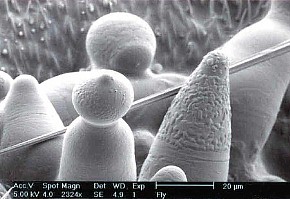
2005.12.08

2005.12.08

2005.12.09
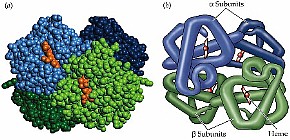
2005.12.09
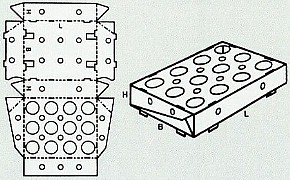
2005.12.09
 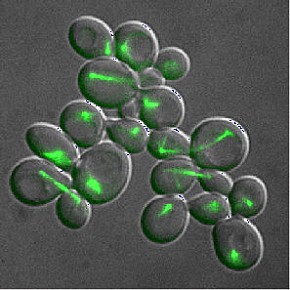
2005.12.11

2005.12.16
2007.06.22 15:03
Anti-Starchitecture Chic
Haven't you heard, Zeitgeist is so yesterday!
2007.06.23 11:33
Anti-Starchitecture Chic
There is a lot of structural and spatial and design innovation going on that makes 'signature buildings' more than only a commercial backdrop. Many 'signature buildings' actually make significant contributions to architectural history. Perhaps a more real issue it that the distinction betweeen hype and history is completely ignored to the point where the hype is what becomes a much distorted history.
2007.06.23 12:56
Anti-Starchitecture Chic
So, within the 'star system' who then are the "stars" and what form-buildings got the press? As large as the realm of architecture is, it's still a finite set, so we can actually be specific rather that general. Gehry, Koolhaas, Eisenman, Hadid--are these at least on the list of 'who is a starchitect'?
How buildings get press is what should be much more studied. For example, having "Guggenheim" attached to any building design will get lots of press because the Guggenheim already has a whole staff department devoted to generating press, besides the fact that the major mission of the institution itself is to exhibit. Ironically, the "Virtual Guggenheim" by Asymptote was pretty much literally just press.
If starchitects are really just pseudo celebrities, is that then already a sign of just how relative starchitect status is?
Is "a style" really such a bad thing? I actually see a lot of diversity from architect to architect, and even with a specific architect's oeuvre there is often diversity at least via nuance, if not actually just plain diversity. I thus question the full validity of "same bag of (increasingly superficial) formal tricks."
One could also argue that there is now-a-days a whole lot more critical architectural criticism going on, but it all right away falls into various camps--New Urbanism, Bilbao effect, anti-starchitect, etc.(?)
Most people I know know absolute nothing about architectural style. I'd go so far as to say that even most architects don't know all that is really going on design-wise now-a-days.
"Lesser known architects follow the public's new tastes."--that sounds very subjective to me.
"Architecture" loses yet another battle." --Is an imaginary battle really a battle? Can an imaginary battle really be lost?
I'll leave it at that, but I think the second set of points of regarding Archigram and backlash casts much too large a net, with big holes. Somewhat insular itself even.
parting shot:
Architects can well design buildings, put I don't think they'll ever be able to design clients.
2007.06.24 14:10
Anti-Starchitecture Chic
Funny how the lion's share of great architecture was created before there even was a camera with film.
My favorite line from Mann's Joseph and His Brothers comes almost at the very end--"They used their own lenses."
Maybe I'm rare, but the top of the list of my preferred architectural representation has always been the ichnographia, the plan view, and the photographic image almost always at the bottom of the list, except when it's fucked by context--site of street shooting a day or two after the theaters here were opened.
Has the preferred photographic architectural image really only blinded "us" to the actual relativity of it all.
2007.06.24
Quondam as some strange un-scientific fiction architectur(al novel?)
2007.06.25 10:36
For the pleasure of sharing ideas, through the poetry of the printed word
What I'd like to do more of is 'fictitious historical dialogue'.
As of yesterday, reading Duboy (again) along with ongoing Montesquieu and spotty Foucault--bricolage plus letters plus Las Meninas etc. Mix that with 'fictitious historical dialogue' and you have my next book project.
It's a book about all kinds of style. The working title is über œuvred e suicidal. Piranesi hires a Quaker lawyer to fix historical inaccuracies while the Quaker lawyer hires Piranesi to design an historically accurate house. Neither knew of the other's true propensity--playful double-meaning meets good-natured honesty--yet they discover themselves to be a formidable team. You'll think you're laughing and you'll laugh about thinking.
2007.06.25
various inspirations
...been reading Duboy's Lequeu again to pick up on the bricolage. ...today wrote about Piranesi and Miers Fisher (a Quaker lawyer).
The Quaestio Abstrusa backgrounds should become a renewed inspiration. ...start combining past drawings as well as past models.
2007.06.26 11:55
For the pleasure of sharing ideas, through the poetry of the printed word
I love being inspired, thus the new working title of my next book project is The Faux Failing Memory.
The interesting thing about the written word is that you can almost always tell when the author isn't being completely honest. At least I can.
2007.06.26 13:33
For the pleasure of sharing ideas, through the poetry of the printed word
Perhaps at first it's instinctual, and then, as one learns to trust one's instincts, it becomes a skill. That's at least the reader's part. The writer gives off clues within their style. Citing "failing memory" is often such a clue.
Quilian, you're not suggesting that people at archinect aren't always being completely honest are you?!? Such a prick would surely burst the (hot air?) balloon.
2007.06.26 14:29
For the pleasure of sharing ideas, through the poetry of the printed word
A plain old lie is for sure less honest than memory. Memories are mental reenactments, and, for sure, a reenactment can never be the original. Those are givens.
Yes, one can certainly tell an unwitting falsehood, and that's usually due to not knowing all pertinent information, or some such circumstance. Whereas to actually tell a lie means that indeed the liar does know the honest truth, but chooses not to express it. In which case the memory is indeed truthful, although the expression of the memory isn't truthful.
How exactly does one write selfishly? Is that like writing notes to oneself?
2007.06.26 21:28
For the pleasure of sharing ideas, through the poetry of the printed word
....since this thread is about architectural writing, it is worthwhile noting that Piranesi, within the Ichnographia Campi Martii, utilized plans, plan positionings and Latin labels to create a readable text. This is rare, if not unique, within the realm of architectural writing. You can read the full 'love and war' story here.
You may not have slept through roman architecture class. Perhaps your memory fails you more than you know.
2007.06.26
the working title musuem
I could write an architectural novel entitled "the working title museum". It could be all the titles and something about them. I suppose there could be images/plans too. It sounds like a lot of work now. It will probably never happen, except I could make it a part of Quondam
| |
2007.07.03
There goes that bilocation again.
"Did you notice how Chapter 3 of Against the Day is entitled "Bilocations"?
"Yes, I did."
"Don't you think it's strange that Pynchon should incorporate "bilocation" into a novel a couple years after you did?"
"Who knows? Maybe Pynchon read The Odds of Ottopia while it was simultaneously written and published online."
2007.07.06 18:18
What was your path to Architecture like?
Saw my floor first plan circa 1960...
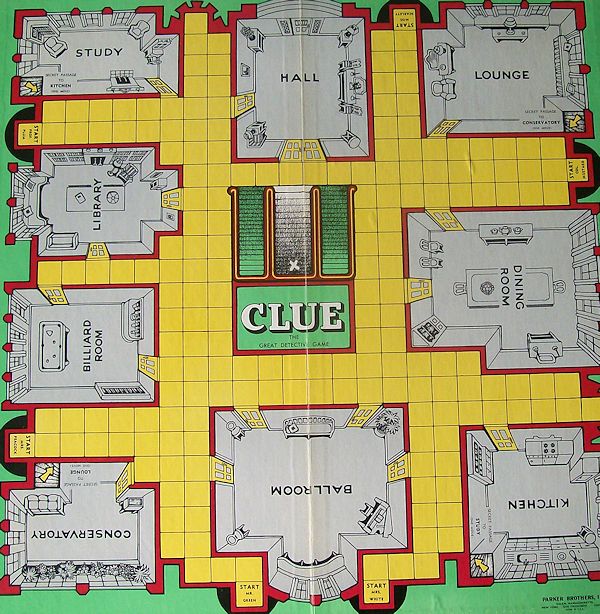
...and it's been a detective game ever since. There's even been a real murder mystery or two.
2007.07.11 16:45
Verb: Featured Discussion
Is it all still pretty operative criticism?
Perhaps architectural criticism needs to begin operating differently where:
some criticisms are extreme™
some criticisms are fertile™
some criticisms are pregnant™
some criticisms are assimilating™
some criticisms are metabolic™
some criticisms are osmotic™
some criticisms are electro-magnetic™
some criticisms are total frequency™
But maybe that will only happen when (we begin to realize that):
some architectures are extreme™
some architectures are fertile™
some architectures are pregnant™
some architectures are assimilating™
some architectures are metabolic™
some architectures are osmotic™
some architectures are electro-magnetic™
some architectures are total frequency™
2007.07.11 17:52
Verb: Featured Discussion
C(riticism) = m(ainstream)Ad(vertising)²
2007.07.12 09:29
Sarcastic Architecture
Is sarcasm more of a dark comedy? (I always thought so.)
Is seminal post-modern pastiche also sarcastic? I suppose it did taunt establishment Modernism keenly (and perhaps even somewhat bitterly?). Although one could say establishment Modernism became much more embittered because of it.

The D+S example above intrigues me the most. It is indeed taunting and you can almost taste the bitterness. (Not exactly architecture though.)
Perhaps Rossi haunts more than taunts.
Does any sarcastic architecture wound feelings? The Eisenman West Avenue proposal (next to Ground Zero) seems to have that potential.
Has Koolhaas (subliminally?) made a whole career out of taunting and bitterness?
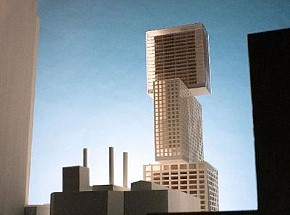
2007.07.12 22:33
Sarcastic Architecture
MVRDV have an interesting way of taking things/concepts to an extreme. Have they maybe learned from "Exodux, or the Voluntary Prisoners of Architecture"? I like their imagination nonetheless. A breed of Dutch sarcasm utilized when most useful?
"Holy Stations of the Cross, Batman!"
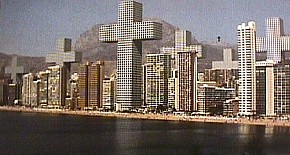
2007.07.17 10:32
on aesthetics
I like it when content takes on a form that very easily recognized yet not very easily digested.
Yet some people might still argue that anything looks better with a frame.
Did someone mention cocktails?
aesthetics eingeschnudeled
2007.07.17 12:07
on aesthetics
Perhaps that's what the artist/architect does, apply form to content. Yet, in the case of Piranesi's Ichnographia Campus Martius at least, it is the form within a context that discloses the content (if the observer is astute enough to find it)--the content is implied rather applied.
2007.07.17 12:41
on aesthetics
Any archinecters ever been to Kaliningrad? Apparently the place is completely German in form yet completely Russian in content. (At least that's what a East Prussian descendant told me what his father's return there 15 years ago was like.)
2007.07.18 08:35
on aesthetics
The fractured standard is just that, fractured. There is no universal, and indeed there never really was. Just look at what was going on (somewhat globally) in the early 1730s. There is no real universal standard, rather standards were then (and still are?) relative to place.
2007.07.18 09:37
on aesthetics
I'm not exactly sure how "any definition of place is going to be arbitrary."
There is a somewhat unquestioned methodology to architectural history, which categorizes types of architectures by period (time) and location (place). And this is mostly a Western European standard. Yet architectural history is rarely written where it demonstrates how types of architectures actually overlap when architecture is culled from all over the globe at any given time.
If you're not arbitary about place and simply say the globe, and then look to see what types of architecture were being done (on the globe) at any given time, you'll see just how diverse architecture always was. Interestingly, this is how we judge the present (and conclude that standards are fractured), but it's not how the past is/has been judged.
I agree that architecture for the most part is arbitrary in the sense that most architecture reflects a set of specific decisions (arbitration), but only a small percentage of architecture is outright whimsical. Personally, it's refreshing to see just how diverse architecture has always been.
Otherwise, the real modus operandi of aesthetics is "what is the cash value?"
07071801 Le Composites Calder Museum Acropolis Q on the Parkway plans
2380i01
2177i10
07071802 Le Composites schematic elevations
2380i02
2177i11
2007.07.23 09:54
Selling Out: Architects and their Archives
commodify the artifact
virtualize and open source the archive
2007.07.30 19:16
Necessary architecture books
worth holding your breath for....
Towards a Squeezed-Out Architecture
Heavy Volume Everywhere
The Architect Came Twice (in foreign tongue)
One Size Fits All
2007.07.30 22:20
Necessary architecture books
a must for all clients:
Does Your Architect Wear Boxers or Blobs?
2007.07.31 11:36
Learning from Las Vegas + SMLXL = Dubai
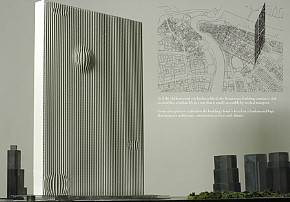
flip up

flip down
2007.07.31 17:55
Necessary architecture books
Not just reading other things, how about writing other things too? Architectural literature could be so much more creative.
2007.08.04 14:41
Koolhaas & Eisenman Discuss "Urgency" at the CCA
About 180 more years of an architecture dominated by the combined assimilating and metabolic imaginations, and then roughly 500 years of an architecture dominated by a pure metabolic imagination. All the while the profane osmotic imagination remains in the background. So much for the physiology, morphologically a bi-polar structural network will continue to branch and grow (till completion c. 3091).
2007.08.04 17:32
Koolhaas & Eisenman Discuss "Urgency" at the CCA
I thought the point was Archaeologies of the Future.
'Opaque' perhaps, but never without clues. The way I see it Koolhaas's architecture becomes him while Eisenman becomes his architecture. [Vanbrugh is at the top of the list if that helps.]
"Pejorativity" is an important chapter in The Irrelevancy Style of Architecture.
My tendencies are more coincidental than anything else.
2007.08.06 09:02
not looking forward to
I never went to grad school and all I do is "explore and expand upon my most deeply-felt interests."
2007.08.08 12:03
spreading like a virus...(discuss)
[googled "redesigning newness" and received no results]
Redesigning Newness: Architecture's Search for an Answer to Sprawl
2007.08.08 12:11
spreading like a virus...(discuss)
I wouldn't confuse the issue by right away associating 'newness' with 'stuff'. Concentrate on the newness factor, whether it's a brand new home or a renewed central business district, and start to imagine how newness can be somehow packaged differently.
07081001 Jung Zaha House model perspectives
2382i01
b
c
07081003 Villa Stein de Monzie in Terrain model
2383i01
07081301 Villa Stein de Monzie in Terrain elevation perspectives
2383i02
07081402 Villa Stein de Monzie in Terrain model axonometric horizontal mirror-copy experiment perspective
2383i03
07081403 Villa Stein de Monzie in Terrain Wall House 2 in Terrain model
2383i04
07081404 Villa Stein de Monzie in Terrain Wall House 2 elevations axonometrics perspectives
2383i05
07081604 Trivilla Savoye model
2385i02
07081605 Trivilla Savoye perspectives
2385i03
2007.08.20 18:03
thesis... phenomenology
Is there any proof that "we can't inhabit it--outlandish, novel architecture--in a meaningful way"?
2007.08.20 21:27
thesis... phenomenology
Where is the proof "that architects write theories then build buildings in relation to the text, and then act as if the building is a proof of their ideas"?
2007.08.21 11:27
"...a shift into spontaneous mode,
Instinct is not the same thing as reason. To start with, instinct is much quicker.
2007.08.21 12:22
"...a shift into spontaneous mode,
Marketing an architectural firm and designing to generate publicity are not the same thing.
2007.09.06
as architecture once was
I thought yesterday that Quondam could begin delivering its content as architecture once was. I have a whole collection of prints and books that show architecture as it once was, so I can start using them to exhibit architecture as it once was. And, of course, "quondam" actually means "once was".
The flip side is to also exhibit what architecture is going to be. Yet even the recent past is now architecture as it once was. I guess it's worth it to keep this idea as an ongoing agenda for Quondam, one of several agendas from now on.
2007.09.06
next use of Quondam
...utilize the model (and drawing) collection, and Quondam... ...a reflection of all that. The "story" could be Unthinking an Architecture.
The main theme is the virtual place that Quondam is capable of being--a place and an exhibit and a book all at once. Does that add up to some kind of strange new architecture? It might. And there is the notion of connecting all the aspects of Quondam('s collection) together. It might just be the unusual and/or unexpected combination of material that manifests an avant-garde impact.
...may become much more poetry than prose
2007.09.15
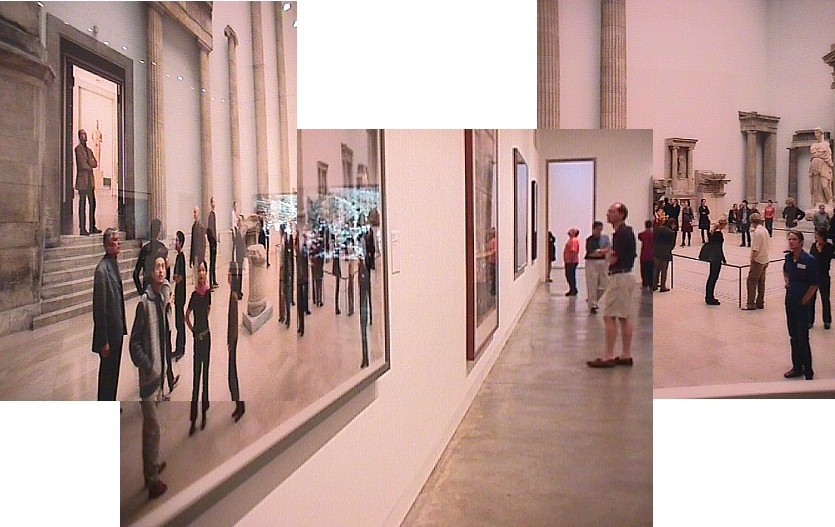
Museum Trip 2002.09.15.003
2007.09.22
Old School of New Thinking
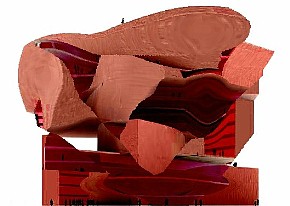
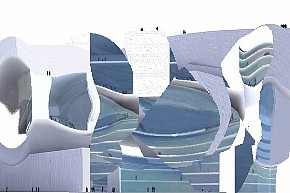
2007.10.02 21:40
innovative program
Figure out a way to make the new arrivals famous for 15 minutes. Perhaps ongoing guest spots on a perpetual reality NYC/TV show with lots of sink or swim competitions and flash-in-the-pan stuff. Fleeting fame really is the new normality.
07100201 Cut & Paste Museum plan museum plans
2386i01
2007.10.03 08:04
Looking for a Lebbeus Woods drawing ...
In the future, everyone will be a self link, with absolutely nothing to be sorry about. Self link architects will be all the rage, even.
And guilt will be the new mythology.
2007.10.03 08:16
thesis
I suggest you pursue all three topics in one--a marine architecture hi tech airport designed to make everyone feel like they're on stage. Throughout this great hybrid machine of notoriety are virtually infinite opportunities to globally link oneself.
2007.10.03 09:09
thesis
Perhaps you should design some kind of institution where architects can go to become less bitchy about petty things and in turn more ideas oriented. I see franchise opportunities--a Pride-Aid on corners everywhere.
2007.10.03 15:23
Looking for a Lebbeus Woods drawing ...
I don't doubt that Woods is a nice person, but architecturally I find the work old-fashioned, futuristic in a late-nineteenth century kind of way (like Dubai is futuristic in a mid-twentieth century kind of way). The angst-ridden designs remain frozen in artificiality due primarily to a virtually complete lack of human investment.
2007.10.03 15:43
Apocalyptic Urbanism
Just wait:
Due to global warming Greenland becomes prime real estate. As a result Denmark becomes one of the northern hemisphere's big oil-rich nations. Jet-setters winter in Dubai and summer in Greenland.
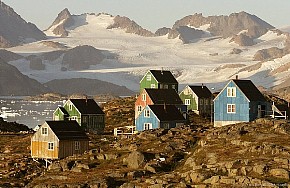
I've never set foot on Greenland, but I have been there (back in 1963). Our plane needed fuel, so we landed somewhere in Greenland. It was night, so you couldn't see much, but I distinctly remember a single light burning over the door of a small building next to the runway. I remained enchanted.
2007.10.04 13:13
Apocalyptic Urbanism
How much of New York City 1807 still exists today? How much of New York City 2007 will still exist in 2207?
2007.10.04 16:18
Apocalyptic Urbanism
Catastrophic urbanism might be a better term, and indeed New Orleans during and post hurricane Katrina provides an ample textbook on the subject. Pockets of civilization may well succumb to catatrophes, but the rest of civilization does just go on. At least that's the situation now, and probably for some time to come. Even the Great Tsunami 2004 had widespread effect, but still on only a small portion of civilization at large.
It's probably more worthwhile to contemplate catastrophic urbanism than to conjecture apocalyptic urbanism.
2007.10.08
strange architecture idea
I have this vague idea of how to generate virtual architecture via Quondam, and it has to do with "creating" buildings that relate to my letters and notes. It's sort of a mnemonic devise, but also a form of design inspiration as if the various texts were the programs of the buildings. I have no idea of how this approach would be implemented, but I see it as a means to create an environment where all my material connects together.
Part of this idea is also to just start using Quondam as an art/experiment project (as opposed to the archive that it now is). Plus I want the cad graphics to become completely integrated.
OMA Apraksin Dvor St. Petersburg
2007.10.14 17:52
Negative notes
"In Modern architecture we have operated too long under the restrictions of unbending rectangular forms supposed to have grown out of the technical requirements of the frame and the mass-produced curtain wall. In contrasting Mies' and Johnson's Seagram Building with Kahn's project for an office tower in Philadelphia it can be seen that Mies and Johnson reject all contradictions of diagonal wind-bracing in favor of an expression of a rectilinear frame. Kahn once said that the Seagram Building was like a beautiful lady with hidden corsets. Kahn, in contrast, expresses the wind-bracing--but at an expense of such vertical elements as the elevator and, indeed of the spaces for people."
--Robert Venturi, Complexity and Contradiction in Architecture (New York, MoMA, 1966), p. 56.
"Yet in City Tower, Kahn no more succeeded in making strides in architectural structure than he had in the Art Gallery at Yale. He erroneously discussed the project in tectonics terms, justifying City Tower's form by arguing that it best expressed buttressing against wind stresses: "The mind envisions a construction of a building growing from a base crossing its members as it rises against the forces of the wind." Yet neither Tyng nor Kahn checked their wind-stress argument with a structural engineer, who would have told them that because of the forces of gravity, a tower rising in a more-or-less straight vertical is dramatically more efficient."
--Sarah Williams Goldhagen, Louis Kahn's Situated Modernism (New Haven, Yale University Press, 2001), p. 78.
"Yes, architects sometimes used to make stuff up just to justify (the shape) their designs."
"What do you mean 'used to'?"
07101801 IQ0 plans.
2278i07
2007.10.27 13:40
Collage Architecture
I remember those collages in Education of an Architect I from back in the late 1970s; had no idea who did them back then, and vaguely recall later learning they were by Libeskind. I could probably find some very old "xerox" copies if I looked hard enough. Now, in retrospect, I'd say they had a strong, albeit subliminal, influence on some of my operations. And add to that an early CAD training (1983), the whole 'cut and paste' ethos of computer processing, along with the overall ease of data manipulation, then opened a whole new field with respect to architectural drawing.
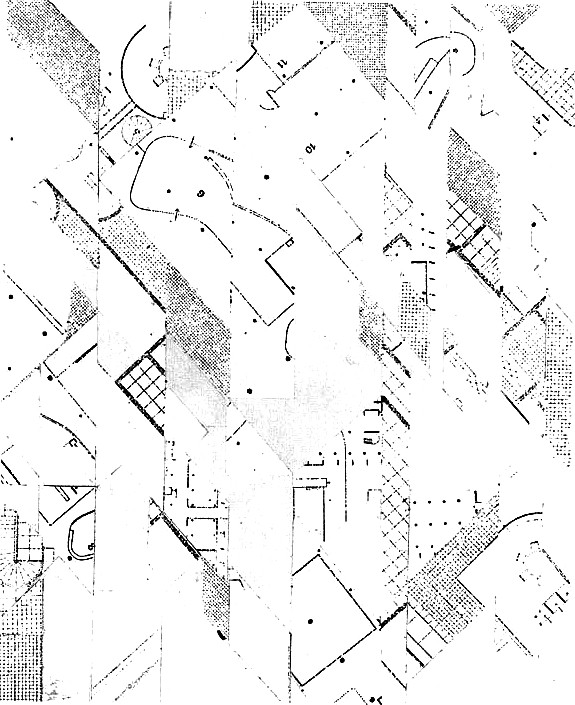
2007.11.10 16:15
The End of Boxes
The Beginning of Boxes?
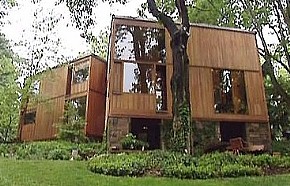
Louis I. Kahn, Norman Fisher House, construction completed June 1967.
2007.11.10 18:21
The End of Boxes
The Beginning of Blobs?

Le Corbusier, Electronic Calculation Center Olivetti at Rho-Milan, 1963-64.
2007.11.11 16:10
The End of Boxes
Conjecture: Kiesler's Endless House project may well have inspired the 'blob' elements within Le Corbusier's Electronic Calculation Center Olivetti at Rho-Milan for there are more endless-house-like elements within the Olivetti Center design.
2007.11.11 17:30
The End of Boxes
from Oeuvre Complète, Vol. 7:
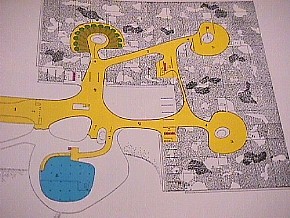 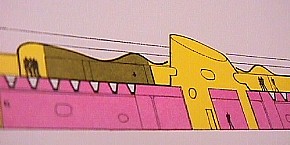 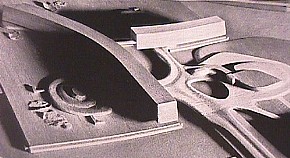
The design is an interesting combination of box, blob and mat.
07112801 Duchamp Inn Calder Museum plan model
2369i03
07113001 Duchamp Inn perspectives
2386i01
07113002 Suburban Poché plans
2248i02
2007.12.01 08:31
Consumerism and Monumentality
canon : the body of rules, principles, or standards accepted as axiomatic and universally binding in a field of study or art
axiom : a self-evident truth that requires no proof
That memory, whether it be lucid or vague, functions primarily as a reenactment is axiomatic.
The operative word/notion within the definiton of canon is "accepted," which adds substantial subjectivity. Thus canons, in and of themselves, are not axiomatic.
Canons emerge via power play.
power play : an action, stratagem, or maneuver, as in politics or business, by which power is concentrated or manipulated in order to subdue a rival or gain control of a situation.
That canons emerge via power play may well be axiomatic.
Is it axiomatic then too that novel canons emerge via novel power plays?
[Did you just read a novel axiom?]
2007.12.03 08:05
Guess Who
..but what about the subcategories of profane and sacred space?
fertile space
conceptual space
assimilating space
metabolic space
diaphragmic space
networked space
osmotic space
electromagnetic space
all-frequency space
2007.12.03 09:19
Guess Who
Both the profane and the sacred are human "being". Take away the qualifying hierarchy and you'll see the whole picture, which is much more.
After reading The Sacred and the Profane perhaps pick up Slovoj Zizek, The Puppet and the Dwarf: The Perverse Core of Christianity. It might help fill out the "whole picture."
...the subcategories of profane and sacred space:
fertile space
conceptual space
pregnant space
assimilating space
metabolic space
diaphragmic space
networked space
osmotic space
electromagnetic space
all-frequency space
for a school I'd go:
inside -- assimilating space and all-frquency space
outside -- metabolic space
|